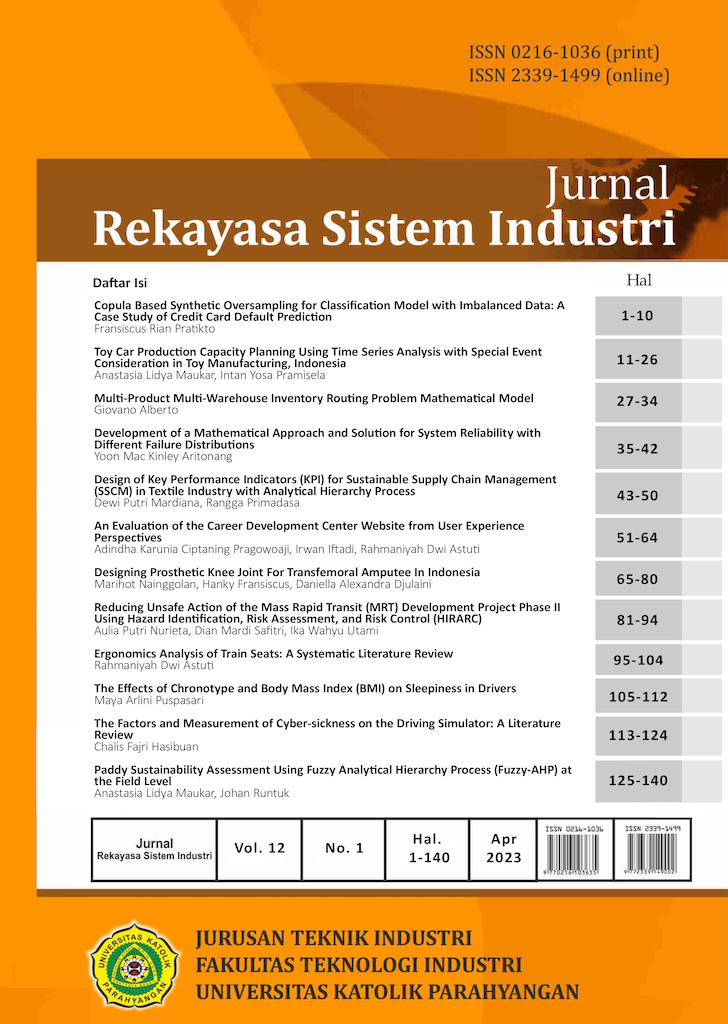Designing Prosthetic Knee Joint For Transfemoral Amputee In Indonesia
DOI:
https://doi.org/10.26593/jrsi.v12i1.6207.65-80Keywords:
transfemoral amputee, prosthetic knee joint design, computer aided design, 3D printingAbstract
The main problem that experienced by transfemoral amputees in Indonesia is limited mobility, so they need prosthetic limbs to walk and do daily activities. However, the limited movement and also expensive price of the prosthetic knee joint causes not all the needs of the transfemoral amputee can be accommodated.
This study aims to design the artificial leg joints that can meet the needs of the Indonesian amputees. Stages of this research include searching for unmet user needs, developing concepts to produce a prosthetic knee joint repair plan and evaluating it. From this research, six initial concepts of prosthetic knee joints, and one concept (AD+) has been selected using concept screening and concept scoring. A physical prototype has been made using printer 3D.
The final prosthetic knee joint using polycentric knee type joint with constant friction drive type, having a human knee joint shape, has a height dimension of 188.84 millimeters and width of 82.46 millimeters, has a maximum bending angle of 151.4O, mass 598, 62 grams, can support a maximum load of 272 kilograms (according to CAD model), made of nylon, has a production cost about one million rupiah (less than USD100), has a single speed and impact high level ambulation, and has a rotator and lock function. Evaluation is done by simulation and qualitative assessment. The results showed that 68.42% of the needs were met well and 31.58% were adequately met by this new proposed prosthetic knee joint design.
References
American Society for Quality. (2016). Learn About Quality. Retrieved from ASQ: http://asq.org/learn-about-quality/qfd-quality-function-deployment/overview/overview.html
Berke, G., Buell, N., Fergason, J., Gailey, R., Hafner, B., Hubbard, S., et al. (2008). Transfemoral Amputation: The Basics and Beyond. Prosthetics Research Study .
Cross, N. (2000). Engineering Design Methods: Strategies for Product Design (Third Edition). West Sussex: John Wiley & Sons Ltd.
Hajon, A. M. (2016). Usulan Perbaikan Rancangan Kaki Palsu di Bengkel Kelompok Kreativitas Difabel. Bandung: Universitas Katolik Parahyangan.
Healthline, E. (2015, April 6). In Depth: Leg. Retrieved from www.healthline.com: http://www.healthline.com/human-body-maps/leg#seoBlock
Japro Medika. (n.d.). Daftar Harga Kaki Palsu, Tangan Palsu, dan Alat Bantu Ortopedi. Retrieved from japromedika.com.
Jones, O. (2017, January). The Knee Joint. Retrieved from teachmeanatomy.info: http://teachmeanatomy.info/lower-limb/joints/the-knee-joint/
K.H.E. Kroemer, H. K.-E. (2001). Ergonomics: How to Design for Ease and Efficiency, Second Edition. Upper Saddle River: Prentice Hall.
Limbless Association. (2012, November). Retrieved from www.limbless-association.org: http://www.limbless-association.org/images/Types_of_Amputation.pdf
Mangunsong, F. (1998). Psikologi dan Pendidikan Anak Luar Biasa. Jakarta: Lembaga Pengembangan Sarana Pengukuran dan Pendidikan Psikologi (LPSP3).
Norton, K. M. (2007). A Brief History of Prosthetics. Manassas: Amputee Coalition.
Otto, K., & Wood, K. (2001). Product Design: Techniques in Reverse Engineering and New Product Development. Upper Saddle River: Prentice Hall.
Quigley, C.P.O., M. J. (2002). Digital Resource Foundation for the Orthoics & Prosthetics Community Virtual Library Project. Retrieved from Chapter 4 - Atlas of Limb Prosthetics: Surgical, Prosthetic, and Rehabilitation Principles : Prosthetic Management : Overview, Methods, and Materials: http://www.oandplibrary.org/alp/chap04-01.asp
Schrott, H. (2009, September). Design for the Disabled. Retrieved from www.wipo.int: http://www.wipo.int/wipo_magazine/en/2009/05/article_0009.html
Sekaran, U. (2010). Research Methods for Business. Chichester: John Wiley & Sons.
Singh, D. P. (2015, September). Knee Range of Motion and Movements. Retrieved from boneandspine.com: http://boneandspine.com/knee-range-of-motion/
Sosial, B. P. (2012). Kementerian Sosial dalam Angka: Pembangunan Kesejahteraan Sosial. Jakarta: Pusat Data dan Informasi Kesejahteraan Sosial.
Ulrich, K. T., & Eppinger, S. D. (2012). Product Design and Development: Fifth Edition. New York: McGraw-Hill.

